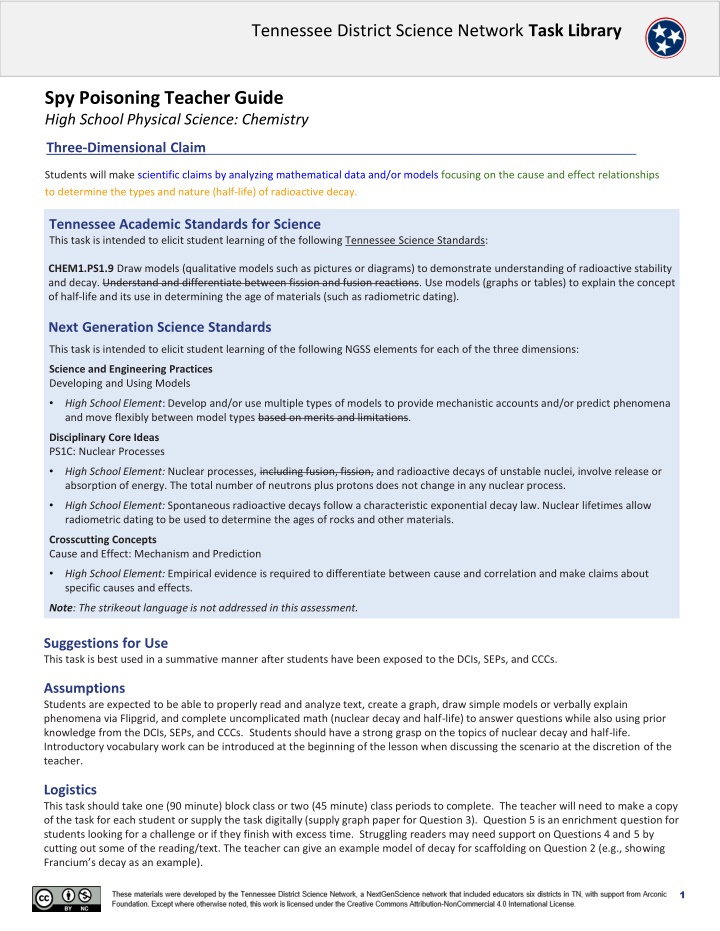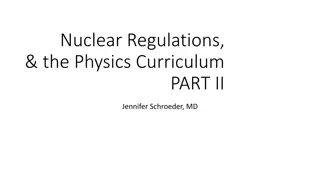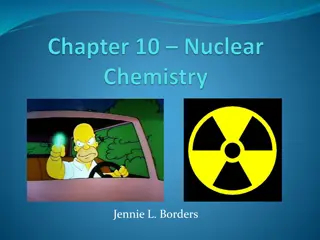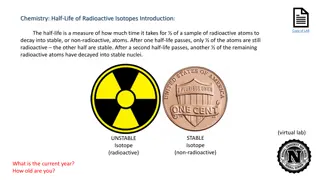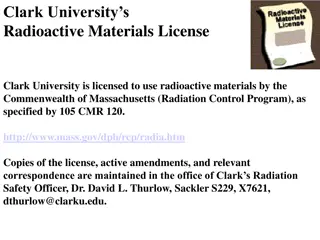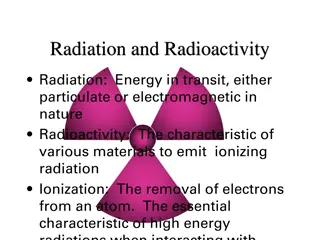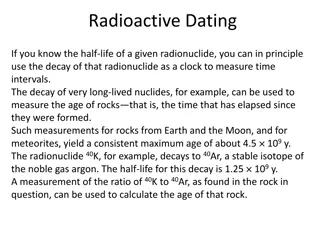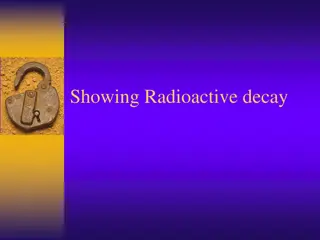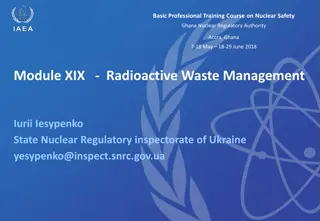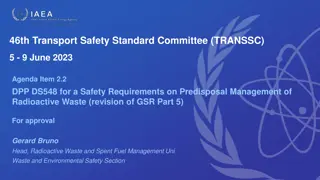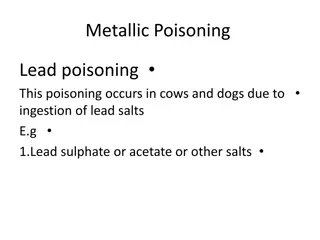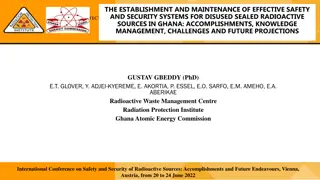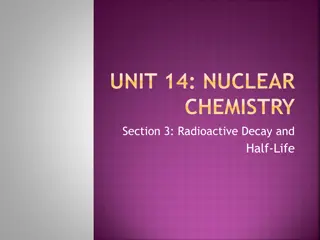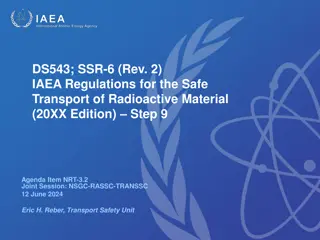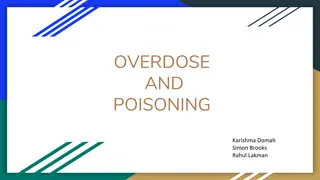Investigating Agent Z's Poisoning: A Case of Radioactive Decay
Agent Z, a double spy, was poisoned with Polonium-210, a heavy, radioactive element. This task challenges students to analyze the cause of his death using concepts of nuclear decay and half-life modeling based on provided data and models. The scenario involves understanding the effects of radioactive decay on unstable nuclei and its implications on radiometric dating. Students will draw models, create graphs, and analyze empirical evidence to make scientific claims about the poisoning incident.
Download Presentation

Please find below an Image/Link to download the presentation.
The content on the website is provided AS IS for your information and personal use only. It may not be sold, licensed, or shared on other websites without obtaining consent from the author.If you encounter any issues during the download, it is possible that the publisher has removed the file from their server.
You are allowed to download the files provided on this website for personal or commercial use, subject to the condition that they are used lawfully. All files are the property of their respective owners.
The content on the website is provided AS IS for your information and personal use only. It may not be sold, licensed, or shared on other websites without obtaining consent from the author.
E N D
Presentation Transcript
Tennessee District Science Network Task Library Spy Poisoning Teacher Guide High School Physical Science: Chemistry Three-Dimensional Claim Students will make scientific claims by analyzing mathematical data and/or models focusing on the cause and effect relationships to determine the types and nature (half-life) of radioactive decay. Tennessee Academic Standards for Science This task is intended to elicit student learning of the following Tennessee Science Standards: CHEM1.PS1.9 Draw models (qualitative models such as pictures or diagrams) to demonstrate understanding of radioactive stability and decay. Understand and differentiate between fission and fusion reactions. Use models (graphs or tables) to explain the concept of half-life and its use in determining the age of materials (such as radiometric dating). Next Generation Science Standards This task is intended to elicit student learning of the following NGSS elements for each of the three dimensions: Science and Engineering Practices Developing and Using Models High School Element: Develop and/or use multiple types of models to provide mechanistic accounts and/or predict phenomena and move flexibly between model types based on merits and limitations. Disciplinary Core Ideas PS1C: Nuclear Processes High School Element: Nuclear processes, including fusion, fission, and radioactive decays of unstable nuclei, involve release or absorption of energy. The total number of neutrons plus protons does not change in any nuclear process. High School Element: Spontaneous radioactive decays follow a characteristic exponential decay law. Nuclear lifetimes allow radiometric dating to be used to determine the ages of rocks and other materials. Crosscutting Concepts Cause and Effect: Mechanism and Prediction High School Element: Empirical evidence is required to differentiate between cause and correlation and make claims about specific causes and effects. Note: The strikeout language is not addressed in this assessment. Suggestions for Use This task is best used in a summative manner after students have been exposed to the DCIs, SEPs, and CCCs. Assumptions Students are expected to be able to properly read and analyze text, create a graph, draw simple models or verbally explain phenomena via Flipgrid, and complete uncomplicated math (nuclear decay and half-life) to answer questions while also using prior knowledge from the DCIs, SEPs, and CCCs. Students should have a strong grasp on the topics of nuclear decay and half-life. Introductory vocabulary work can be introduced at the beginning of the lesson when discussing the scenario at the discretion of the teacher. Logistics This task should take one (90 minute) block class or two (45 minute) class periods to complete. The teacher will need to make a copy of the task for each student or supply the task digitally (supply graph paper for Question 3). Question 5 is an enrichment question for students looking for a challenge or if they finish with excess time. Struggling readers may need support on Questions 4 and 5 by cutting out some of the reading/text. The teacher can give an example model of decay for scaffolding on Question 2 (e.g., showing Francium s decay as an example). 1
Tennessee District Science Network Task Library Spy Poisoning Teacher Guide High School Physical Science: Chemistry Intro to Task Agent Z was a spy who began working for the British government as a double agent. He was discovered speaking ill of his previous boss and within a month he was dead from Polonium-210 poisoning. How were they able to poison him with a heavy, radioactive element, and why did it kill him? Use the articles below and respond to the prompts to investigate. Excerpt from Article 1 Agent Z: Profile of Murdered Russian Spy A public inquiry into the killing of former spy Agent Z has concluded that his old boss approved his assassination. But who was he and why did his death cause such controversy? Agent Z was killed in November 2004. The 43-year-old had been an officer with his country s spy agency, but he fled to Britain where he became a fierce critic of his old boss. In his final years he also became a British citizen. At a central London hotel on 16 November 2004, he had tea with two of his former colleagues, who were also previously spies. Agent Z fell ill soon afterwards and spent the night vomiting. Three days later he was admitted to Barnet General Hospital in north London, where his condition gradually became a cause for concern. On 26 November he was interviewed by a news agency and said he was in "very bad shape" after a "serious poisoning". This is adapted based on a real-world example. Excerpt from Article 2 Polonium-210 Poisoning: A First-Hand Account Polonium-210 (210Po) gained widespread notoriety after the poisoning and subsequent death of Agent Z in London, UK, in 2004. Exposure to 210Po resulted in symptoms that stumped doctors because it looks like the same symptoms from an infection or exposure to chemical poisons, such as thallium. A 43-year-old man presented to his local hospital with acute abdominal pain, diarrhea, and vomiting, and was admitted to the hospital because of dehydration and persistent stomach upset.. He was initially diagnosed with an infection in his stomach and treated with antibiotics. Clostridium difficile toxin was subsequently detected in his stools (feces), which is when he first raised the possibility of being poisoned. Within 6 days, the patient had a low white cell count and his blood was not clotting properly. By 2 weeks, in addition to bone marrow failure, he had evidence of hair loss and inflammation of his digestive system. Thallium poisoning was suspected and investigated but ultimately dismissed because blood levels of thallium, although raised, were lower than poisonous concentrations. The patient continued to deteriorate and within 3 weeks had developed multiple organ failure requiring ventilation, blood filtering, and cardiac support, associated with a drop in consciousness. On the 23rd day after he first became ill, he could not be resuscitated and was pronounced dead. Urine analysis on day 22 the possibility of 210Po poisoning. Results that became available after the patient's death established the presence of 210Po at concentrations about 1,500,000,000 mBq d-1. Tissue tests collected after his death showed where his own cells were destroying themselves and lethal doses of 210Po in several organs. It was estimated that the patient had probably ingested 210Po in the form of polonium chloride, which could be dissolved in a liquid. This delivered very high and deadly radiation doses. Early symptoms of 210Po poisoning are hard to tell apart from those of a wide range of chemical poisons. Hence, the diagnosis can take a long time and even missed. Although body surface scanning with a standard Geiger counter was unable to detect the radiation emitted by 210Po, unusual symptoms made the doctors think of poisoning with radioactive material, with the diagnosis ultimately being made with a urine sample. 2
Tennessee District Science Network Task Library Spy Poisoning Teacher Guide High School Physical Science: Chemistry Question #1 Rubric and Scoring Guidance 1. According to the articles above, Agent Z was murdered through Polonium-210 poisoning. Develop an explanation of Agent Z s death using evidence from the articles and your knowledge of the patterns of the different types of radioactive decay. Be sure to give reasons why the other types of radioactive decay could not be responsible for his death. (You must cite direct quotes/text/data from your sources.) This prompt assesses: DCI Nuclear processes, including fusion, fission, and radioactive decays of unstable nuclei, involve release or absorption of energy. The total number of neutrons plus protons does not change in any nuclear process. SEP N/A CCC Different patterns may be observed at each of the scales at which a system is studied and can provide evidence for causality and explanation of phenomenon. Question #1 Scoring Guidance Score Components of Student Response (SEP, CCC, and/or DCI) Example Responses/Look Fors Includes an explanation that claims the death was caused by a type of radioactive decay. If evidence aligns, there is not a right or wrong answer for this question. Includes multiple pieces of evidence from the articles that support the type of radioactive decay and the implication or pattern of that decay on a human body. This includes how the radioactive particles are expected to interact with the body given their characteristics. Solid evidence should include the method of delivery and time between poisoning and death. Additional evidence could include symptoms or the failure of the Geiger counter to detect radiation. Includes at least one plausible reason citing the articles for why the cause and effect relationships of other types of decay could not explain his death. Even though alpha is the correct answer, students can reason any type of decay as long as they support their answers with scientific evidence/ the pattern of decay and evidence from the articles. Exemplary Agent Z died from alpha poisoning as the article states that thallium levels were raised and Polonium 210 was detected in his system. Alpha decay occurs predominantly in elements with an atomic number beyond 83 and Polonium has an atomic number of 84. Alpha decay would have to be delivered by ingestion as it can t penetrate skin due to the size of the helium nucleus. Beta and gamma decay are not possible as these types of radiation can penetrate the skin, meaning they would not stay in the body to cause they type of damage that was caused. Even though alpha is the correct answer, students can reason any type of decay as long as they support their answers with scientific evidence and evidence from the articles. Includes an explanation that the death was caused by a type of radioactive decay. The response either included limited evidence or all the evidence cited does not align with type of radioactive decay in the explanation. Response provides minimal, if any, connection between the type of decay and how it might interact with the body. Approaching Proficient Agent Z died by alpha radiation because it is the most powerful. Agent Z died by alpha (beta or gamma) decay. Entry Level Includes an explanation that the death was caused by a type of radioactive decay. 3
Tennessee District Science Network Task Library Spy Poisoning Teacher Guide High School Physical Science: Chemistry Question #1 Scoring Guidance Complete Student Response - Example Score and Score Rationale, if applicable: Exemplary Polonium-210 must undergo alpha decay based on Agent Z s symptoms presented in the two articles. As Article #2 states, Agent Z died 23 days after being poisoned, which suggests that the radioactive decay that caused his death must have high ionizing power such as that found in alpha decay. Because alpha particles are so large (a helium nucleus), as compared to beta decay (electron) and gamma decay (electromagnetic wave), it has much greater ionizing power, thus killing cells quickly, which eventually led to organ failure. In addition, Article #1 suggests that the poisoning occurred through ingestion of tea. Ingestion of alpha particles would be the only way that alpha decay could hurt a person internally. Because alpha particles are so large, they can be stopped easily by a barrier, such as skin. The Polonium-210 had to be ingested in order to cause damage. Beta and gamma decay have greater power due to their small size and could have had an easier method of delivery, such as through exterior contact with the skin. However, this also means that beta and gamma decay could have easily left his body before causing lethal harm. Feedback/Questions to support next level thinking for students: Which of the types of radioactive decay might not be able to penetrate the skin of an individual from the exterior? Now, if that type of decay was inside a person would there be a potential problem? If so, what would that be? Incomplete Student Response - Example A Score and Score Rationale, if applicable: Approaching Proficient Feedback & Next Steps for Students to Make Progress: Agent Z was poisoned through alpha decay. It is more harmful than beta and gamma decay once it is in the body. Alpha has the lowest penetrating power; therefore, he had to drink it. In what way is alpha particle emission more harmful than beta or gamma? What does the article say? What type of pattern does one see in alpha vs beta vs gamma decay? Incomplete Student Response - Example B Score and Score Rationale, if applicable: Entry Level Agent Z was poisoned through alpha decay because it was in his body. Feedback & Next Steps for Students to Make Progress: What is the general pattern for alpha decay? What is the pattern of penetrating power for each type of decay. What evidence does the article give that might match one of the patterns you wrote above? Score: Example of how you would score that response Scoring Rationale: Reasoning for the score you gave connected to the +1 statements from the scoring guide Feedback for Student: What feedback for the student would you recommend given the example response, with the goal of supporting learning toward missing components in their responses 4
Tennessee District Science Network Task Library Spy Poisoning Teacher Guide High School Physical Science: Chemistry Question #2 Rubric and Scoring Guidance Learn more about Polonium-210 and its properties by reading/analyzing the information in the table provided below: Po-210 Physical Properties Po-210 Health Effects Half-life = 138 days Non-hazardous outside the body # of protons = 84 Dangerous via ingestion or inhaling # of neutrons = 126 Damages vital organs like the kidneys and liver 25 different isotopes Cells DNA gets fragmented thus causing cell death Low melting temperature Acceptable ground/fresh water levels: 0.75 ppb or less Acceptable human body levels: 15.5mBq d-1 Source: https://hps.org/documents/po210fact 2. What about the human body as a system made the delivery of Polonium-210 in Agent Z s tea, rather than it being transferred through the skin by coating the tea cup handle, important for poisoning him? Use your knowledge of the patterns of radioactive decay to explain why the spy had to drink tea for this type of poisoning to work. Draw a model of the decay of polonium-210 in relation to the delivery technique (drinking tea) to explain how Polonium-210 was used to poison the spy. In your model, make sure that protons, neutrons, parent nuclide, and daughter nuclide are labeled clearly. Write an explanation of your model below your drawing or use Flipgrid to explain the model you drew. This prompt assesses: DCI Spontaneous radioactive decays follow a characteristic exponential decay law. [Nuclear lifetimes allow radiometric dating to be used to determine the ages of rocks and other materials.] SEP Develop and/or use multiple types of models to provide mechanistic accounts and/or predict phenomena, and move flexibly between model types based on merits and limitations. CCC Empirical evidence is required to differentiate between cause and correlation and make claims about specific causes and effects. 5
Tennessee District Science Network Task Library Spy Poisoning Teacher Guide High School Physical Science: Chemistry Question #2 Scoring Guidance Score Components of Student Response (SEP, CCC, and/or DCI) Model includes two parts: delivery inside the human body and delivery outside the human body. Both models include the following components: Skin Human body Po-210 Energy Alpha Particle Daughter nuclide Exemplary Interactions in the model include: Alpha particle interacting with system boundary (skin) or traveling around the body (ingestion) Arrows representing decay and movement of particles Explanation of model includes that the size of the alpha particle dictates how it interacts with the human body as a system. Model includes two parts: delivery inside the human body and delivery outside the human body. Approaching Proficiency Model includes components from exemplary response but does not include implications or interactions with the body. Entry Level Model is incomplete and/or not used to explain why the poison needed to be delivered so that it would be ingested. 6
Tennessee District Science Network Task Library Spy Poisoning Teacher Guide High School Physical Science: Chemistry Question #3 Rubric and Scoring Guidance 3. Why was Polonium-210 used to poison Agent Z and not a different element? Francium-223 and Americium-243 are also radioactive isotopes that decay in the same way as Polonium-210. The graphs below represent the half-lives of Francium-223 and Americium-243. Sketch a graph representing the half-life of Polonium-210. Compare the three graphs to identify the pattern of radioactive decay among these isotopes and make a scientific claim as to why Polonium-210 was used instead of Francium-223 and Americium-243. Justify your claim with evidence from the graphs. 7
Tennessee District Science Network Task Library Spy Poisoning Teacher Guide High School Physical Science: Chemistry Question #3 Rubric and Scoring Guidance This prompt assesses: DCI Spontaneous radioactive decays follow a characteristic exponential decay law. Nuclear lifetimes allow radiometric dating to be used to determine the ages of rocks and other materials. SEP Develop and/or use multiple types of models to provide mechanistic accounts and/or predict phenomena, and move flexibly between model types. CCC Empirical evidence is required to differentiate between cause and correlation and make claims about specific causes and effects. Question 3 Scoring Guidance Score Components of Student Response (SEP, CCC, and/or DCI) Example Responses/Look Fors Exemplary Student creates a graph using the half life of Polonium-210 and uses the patterns formed to compare the half lives of Polonium-210, Francium-223, and Americium-243 to write a scientific claim that Polonium-210 must have been used to commit the murder. Student graphs the half-life of Polonium-210 correctly at 138 days. Student uses the patterns of the three graphs to correctly concludes that the decay of Francium-223 would be too short to be sued in the murder. Students uses the patterns of the three graphs to correctly concludes that the decay of Americium-243 would be too long to be used in the murder. Students cite evidence from the graph to support conclusions. Approaching Proficiency Student creates a graph using the half- life of Polonium-210 and uses the patterns formed to compare the half lives of Polonium-210, Francium-223, and Americium-243. Student graphs the half-life of Polonium-210 correctly at 138 days. Student uses the patterns of the three graphs to conclude that Francium-223 has the shortest half life, followed by Polonium- 210, with Americium-243 having the longest half life. Entry Level Student creates a graph using the half- life of Polonium-210 but does not correctly compare the three isotopes. Student graphs the half-life of Polonium-210 correctly at 138 days. Student does not determine relative half lives using the patterns from the graphs. 8
Tennessee District Science Network Task Library Spy Poisoning Teacher Guide High School Physical Science: Chemistry Question #3 continued Complete Student Response - Example Score and Score Rationale, if applicable: Exemplary Polonium-210 was used to murder Agent Z instead of Francium-223 and Americium-243. Polonium-210 s half-life is long enough to not be suspected as poison while Francium-223 s half life is so fast, It would make the poisoning immediately obvious. Americium-243 half life is so long that it would not do enough damage to make a difference in Agent Z s lifetime. Feedback/Questions to support next level thinking for students: Assuming those who poisoned Agent Z had to pick up the radioisotope at a lab, transport it to the restaurant, and place it in the tea before Agent Z got there, what would they have had in the tea had they used Francium-234 instead? Incomplete Student Response - Example A Score and Score Rationale, if applicable: Approaching Proficiency The half life of Polonium-210 is in the middle of the three elements. Francium- 223 has the shortest half life. Americium- 243 has the longest half life. Feedback & Next Steps for Students to Make Progress: You have correctly identified the relative half lives of these three isotopes. Why would the murderers have chosen Polonium-210 over Francium-223 and Americium-243? Incomplete Student Response - Example B Score and Score Rationale, if applicable: Entry Level Po-210 was used to poison Agent Z because it decays at the perfect rate to continue to poison him over 100 days and was not able to leave his body. Feedback & Next Steps for Students to Make Progress: How did the half life of Polonium-210 compare to that of Francium-223 and Americium-243? Score: Example of how you would score that response Scoring Rationale: Reasoning for the score you gave connected to the +1 statements from the scoring guide Feedback for Student: What feedback for the student would you recommend given the example response, with the goal of supporting learning toward missing components in their responses 9
Tennessee District Science Network Task Library Spy Poisoning Teacher Guide High School Physical Science: Chemistry Question #4 Rubric and Scoring Guidance 4. Someone dumped Polonium-210 into a freshwater lake that is used for recreational purposes such as swimming, fishing, and boating. The lake has been closed to the public due to high levels of Polonium-210 because the authorities are worried about people drinking the water while swimming or eating the fish. The current levels of Polonium-210 in the lake are 6 parts per billion. When, in number of days, will the lake be safe for recreational use again? Develop an explanation of why the lake is safe for use by analyzing evidence from the articles and the data table, as well as your graph and/or mathematical reasoning to support your claim. You must show your mathematical work to identify the pattern of half-life and cite evidence in the form of direct quotes from the text and data table provided. This prompt assesses: DCI Spontaneous radioactive decays follow a characteristic exponential decay law. Nuclear lifetimes allow radiometric dating to be used to determine ages of rocks and other materials. SEP Develop and/or use multiple types of models to provide mechanistic accounts and/or predict phenomena, and move flexibly between model types based on merits and limitations. CCC Empirical evidence is required to differentiate between cause and correlation and make claims about specific causes and effects. 10
Tennessee District Science Network Task Library Spy Poisoning Teacher Guide High School Physical Science: Chemistry Question #4 Continued Question #4 Scoring Guidance Score Components of Student Response (SEP, CCC, and/or DCI) Example Responses/Look Fors Exemplary Response includes information obtained from the article/table about safe levels of Po-210. Half Life means the time it takes for half of the original amount to decay to a more stable element. Since there is 6 parts per billion currently, one half life would leave 3 parts per billion that had not decayed and remained in the lake. A and a second half life would leave 1.5 parts per billion so more of the original amount still needs to undergo further decay. A third half life would leave .75 parts per billion which the table above states is the acceptable level. However, it might be more safe to ensure a fourth decay occurs so that the lake is below the maximum acceptable level of radioactive material. The article/table states that the half life of Polonium 210 is 138 days so it would take 552 days for four decays to occur. Response includes explanation of the math used to determine when the water would have safe levels of Po-210. Response includes an accurate number of days until the water is at (414 days) or below (552 days) safe levels. Approaching Proficiency Response shows the math and a response with minimal evidence from article/table (e.g., the acceptable levels are at 0.75 ppb). The response does not give a timeframe and just reports in half-lifes. The table states that the acceptable levels are at 0.75 ppb. 6ppb 3ppb 1.5ppb 0.75ppb The lake will be safe after 3 half-lives. Response doesn t explain math or reasoning to show how the evidence supports their explanation. Entry Level Response did not obtain information from the article or did not complete the math in order to support their response. The student attempts the math but gets the incorrect answer. 11
Tennessee District Science Network Task Library Spy Poisoning Teacher Guide High School Physical Science: Chemistry Question #4 Continued Complete Student Response - Example Score and Score Rationale, if applicable: Exemplary (3 points) Half life is the time it takes for a sample s mass to decay down to half the original mass. Taking the starting level (6 ppb) and continuing to half the level until reaching appropriate levels looks like this: 6 ppb 3 ppb 1.5 ppb 0.75 ppb (shows 3 half lives needed to reach acceptable levels) while one more half life 0.75 ppb 0.375 ppb would get it at a definite safe level. 3 half lives x 138 days (obtained from article/table) = 414 days to be at acceptable level while one more half life 414 + 138 = 552 days to below safe and below acceptable levels. So a good range of days would be between 414 and 552 for people to start using the lake again. Feedback/Questions to support next level thinking for students: Lead (Pb) is one of the byproducts of the decay of polonium. Once the polonium is at a safe level we now have to worry about lead levels in the fish. Pb has a half life of 1.5 months in tissues and a year in bones. If 5.0 ppb of lead has entered the fish and an acceptable level is 1.25 ppb, how many months will it take for the Pb to be acceptable in the tissue of the fish and how many years would the level be acceptable in the bones of the fish? Incomplete Student Response - Example A Score and Score Rationale, if applicable: Approaching Proficiency It would take 3 half lives to reach safe levels. 6 to 3 to 1.5 to 0.75 ppb. Feedback & Next Steps for Students to Make Progress: How do you know you are at a safe level at 0.75 ppb? What is half life? What is the half life of Po-210? Incomplete Student Response - Example B Score and Score Rationale, if applicable: Entry level It would take one half life because there wouldn t be as much in the lake at that point. Feedback & Next Steps for Students to Make Progress: What is the starting/ended levels of Po-210? What is half life? What is Po-210 s half life? What is the acceptable level of Po-210? How do you complete the math of a half life problem? Score: Example of how you would score that response Scoring Rationale: Reasoning for the score you gave connected to the +1 statements from the scoring guide Feedback for Student: What feedback for the student would you recommend given the example response, with the goal of supporting learning toward missing components in their responses 12
Tennessee District Science Network Task Library Spy Poisoning Teacher Guide High School Physical Science: Chemistry Question #5: Extension Question Rubric 5. At the time of his death, Agent Z had very high levels of Polonium-210 found in his body. He cannot be buried until his body is at acceptable levels and is not a threat to the freshwater supply. Using the data table for information of acceptable levels of Polonium-210 in the body, determine how long (in years and/or days) it will take for his body to reach acceptable levels to be buried. You must show your mathematical work to demonstrate the pattern of half-life. This prompt assesses: DCI Spontaneous radioactive decays follow a characteristic exponential decay law. Nuclear lifetimes allow radiometric dating to be used to determine ages of rocks and other materials. SEP Develop and/or use multiple types of models to provide mechanistic accounts and/or predict phenomena, and move flexibly between model types based on merits and limitations. CCC Empirical evidence is required to differentiate between cause and correlation and make claims about specific causes and effects. Question #5 Scoring Guidance Score Components of Student Response (SEP, CCC, and/or DCI) Example Responses/Look Fors Exemplary Response includes information from the articles/table used in coordination with mathematical reasoning to support the explanation that the British government would need to store his body in a safe location for 9.1 years before they bury it. Starting levels: 1,500,000,000 mBq d-1 75,000,000 37,500,000 18,750,000 9,375,000 4,687,500 2,343,750 1,171,875 585,937.5 292,968.75 146,484.4 73,242.2 36,621.1 18,310.5 9,155.3 4,577.6 2,288.8 1,144.4 572.2 286.1 143.1 71.5 35.8 17.9 8.9 mBq d-1= 24 half lives x 138 days = 3,312 days/365 days = 9.1 years However, students may also choose to respond without mathematics and say something about his body being ready for burial because the skin will keep the alpha particles inside his body or that he can be buried in a sealed, waterproof casket that wouldn t allow the radioactive material to escape. Approaching Proficiency Response shows the math completed but maybe incorrect. 1,500,000,000 mBq d-1 75,000,000 37,500,000 18,750,000 9,375,000 4,687,500 2,343,750 1,171,875 585,937.5 292,968.75 146,484.4 73,242.2 36,621.1 18,310.5 9,155.3 4,577.6 2,288.8 1,144.4 572.2 286.1 143.1 71.5 35.8 17.9 8.9 mBq d-1 Entry Level Response shows very little to incomplete math with incorrect answer It takes 138 days by going through one half life. 13
Tennessee District Science Network Task Library Spy Poisoning Teacher Guide High School Physical Science: Chemistry Question #5: Extension Question Complete Student Response - Example Score and Score Rationale, if applicable: Exemplary They will have to wait 9.1 years or 3,312 days before burying the spy s body. If the starting levels of Po-210 are 1.5 x 10^9 mBq d-1 and the polonium goes through 24 half lives then that will put the levels at 8.9 mBq d-1 which is below acceptable levels (15.5 mBq d- 1). (+1) Feedback/Questions to support next level thinking for students: Instead of burying the spy the government decides to cremate his body and dump the ashes into a nearby stream. What implications (negative impacts) might occur to the environment/community due to choosing this process? Math below: 1,500,000,000 mBq d-1 75,000,000 37,500,000 18,750,000 9,375,000 4,687,500 2,343,750 1,171,875 585,937.5 292,968.75 146,484.4 73,242.2 36,621.1 18,310.5 9,155.3 4,577.6 2,288.8 1,144.4 572.2 286.1 143.1 71.5 35.8 17.9 8.9 mBq d-1= 24 half lives x 138 days = 3,312 days/365 days = 9.1 years Score and Score Rationale, if applicable: Approaching Proficiency Incomplete Student Response - Example A It takes 24 half lives for the polonium levels to be safe for burying the spy, work below: 1,500,000,000 mBq d-1 75,000,000 37,500,000 18,750,000 9,375,000 4,687,500 2,343,750 1,171,875 585,937.5 292,968.75 146,484.4 73,242.2 36,621.1 18,310.5 9,155.3 4,577.6 2,288.8 1,144.4 572.2 286.1 143.1 71.5 35.8 17.9 8.9 mBq d-1= 24 half lives Feedback & Next Steps for Students to Make Progress: Great job with getting the math set up correctly. How many days is the half live of Po-210? How can you use this amount to determine the total day/years it takes to reach safe levels? Incomplete Student Response - Example B Score and Score Rationale, if applicable: Entry level It takes 138 days for the body to be ready to be buried due to most of the Po-210 being gone after it goes through a half life. Feedback & Next Steps for Students to Make Progress: Good job knowing the half life of Po-210. If you start at such a high level in his body (1.5 x 10^9 mBq d-1), and go through just one half life, wouldn t that still leave levels at 37,500,000 mBq d-1? It would need more time to decay. Try using your calculator and dividing the starting amount in half multiple times to reach safe levels. Score: Example of how you would score that response Scoring Rationale: Reasoning for the score you gave connected to the +1 statements from the scoring guide Feedback for Student: What feedback for the student would you recommend given the example response, with the goal of supporting learning toward missing components in their responses 14
